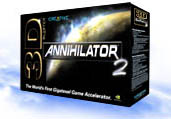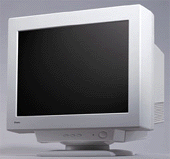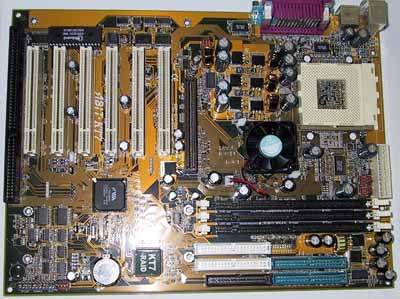Buyer's Guide: High-End Systems - November 2000
by Mike Andrawes on November 16, 2000 12:00 PM EST- Posted in
- Guides
High-end Gaming System
The purpose of
this system is simple – maximum frame rates at all costs. Of course, we already
have a “cost is no object” dream system, so "all costs" isn't taken
quite so literally. We’ve decided to shoot for a price in the $3500 range on
the high-end gaming system. That price is without floppy, keyboard, mouse,
or software. Even though it’s not in the price, we will recommend an OS configuration.
 Processor
– AMD Athlon "Thunderbird" 900 - $200
Processor
– AMD Athlon "Thunderbird" 900 - $200
Clock for clock,
the Athlon may be a bit slower than the Pentium III at games. However, atsimilar
clock speeds, the Athlon holds a significant advantage in price, and for that
reason, we’ve chosen a Socket-A Athlon 900, which means that it's using the
new Thunderbird core with on-die cache.
Besides the direct performance benefits of full speed on-die cache, we also get the side benefit of enhanced overclockability. If you're willing to overclock our CPU, you can save some money by going with the 700 MHz model, most of which will hit 900 - 950 MHz at default voltage, all without exotic cooling. The 900 MHz may overclock a bit better if you're lucky enough to get one with copper interconnects. Of course, there's no guarantee, but the higher speed Athlon's are more likely to be copper.
For more information on all Athlon processors, read our Athlon "Thunderbird" 1.2GHz & Duron 800 MHz Review and our Thunderbird / Duron Overclocking Revealed Aritcle.
Motherboard – ABIT KT7
- $125
The availability of AMD 760 motherboards is still non-existant for the "do
it yourself" market, so we'll have to wait at least another month before
DDR SDRAM systems make an appearance here. The VIA KT133, however is here now
and is the best chipset for the Athlon right now. We recently looked at as many
KT133 Socket-A boards as we could get a hold of and one board stood out head
and shoulders above the rest - the ABIT KT7-RAID. As we noted in the roundup,
the KT7 is the perfect board to overclock with thanks to its completely jumperless
Soft Menu III CPU setup.
Since we only have one hard drive in this system, we'll go with the standard KT7 in place of the KT7-RAID to lower the cost a bit. The only difference between the two boards is the removal of the HighPoint Ultra ATA 100 RAID controller.
The Asus A7V is also an excellent choice that also offers complete overclocking/multiplier control, albeit not in 100% jumperless form. The MSI K7T Pro2 has finally hit the streets soon as well, with new and improved overclocking options, including multiplier manipulation. We expect that the K7T Pro2 will probably become the motherboard of choice in the value systems since it will probably cost about $20-30 less than the ABIT KT7 or Asus A7V. The EPoX EP-8KTA2, Soyo K7VTA, and FIC AZ11E are also decent choices for overclockers.
For more information, read our ABIT KT7-RAID Review, Asus A7V Review, MSI K7T Pro2 Review, and Socket-A KT133 Motherboard Roundup.
Memory – 256MB Corsair
or Mushkin CAS2 PC133 SDRAM (2x128MB DIMM’s) – $140 x 2
Even though memory
is relatively cheap these days, 256MB is more than enough. We could have dropped
down to 128MB, but the savings didn’t justify the performance loss. Besides,
this is our high-end gaming machine, and there’s room in the budget.
As for the exact brand of memory, we recommend Corsair or Mushkin modules. We use them in our test systems and have had absolutely no problems with them.
 Video
card – Creative Labs 3D Blaster Annihilator 2 - $200
Video
card – Creative Labs 3D Blaster Annihilator 2 - $200
Once again, the
Radeon vs GeForce 2 GTS question comes up and once again NVIDIA gets the nod
for their solid driver support.
The majority of GeForce 2 GTS cards on the market are retailing for $300 and selling closer to $250. Creative has undercut the competition with a retail price of $250 and street price closer to $200. True, it's just a plain jane card, with no TV-in/out, but it gets the job done and is the most overclockable GeForce 2 GTS we've tested to date. We were able to push our sample up to 250/395 MHz (core/memory), making it the first 2 Gigatexel (theoretical fillrate) card in the AnandTech lab.
For more information, read our Annihilator 2 Review, GeForce 2 GTS Overclocking Guide, and GeForce 2 GTS Review.
 Monitor
– iiYama VisionMaster PRO 450 - $650
Monitor
– iiYama VisionMaster PRO 450 - $650
Using a Mitsubishi
Diamondtron NF, the iiYama VisionMaster Pro 450 provides a perfectly flat display
surface using the same technology in Sony’s FD Trinitron models, but at a lower
cost. The VisionMaster PRO 450 is a 19” monitor and has been highly acclaimed
here on AnandTech and by owners alike. If you’ve got the funds, we highly recommend
you go with the 22” VisionMaster PRO 510 for about $900.
For more information, read our iiYama VisionMaster PRO 450 and VisionMaster PRO 510 Reviews.











0 Comments
View All Comments